
Orb-weaver spiders are members of the spider family Araneidae. They are the most common group of builders of spiral wheel-shaped webs often found in gardens, fields, and forests. The English word "orb" can mean "circular", hence the English name of the group. Araneids have eight similar eyes, hairy or spiny legs, and no stridulating organs.
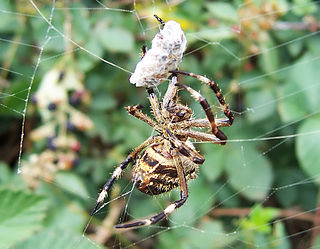
The Australian garden orb weaver spider is a very common species of spider with many variants in size, shape, and colour across the coastal and northern regions of Australia. They have very large abdomens when well-fed and exhibit a tremendous colour-range from off-white through tan, brown to almost black. They have a roughly leaf-shaped pattern on the top of their abdomen with a complex outline that is darker than the surrounding area. There may also be several whitish spots or one or more stripes. The spiders' cephalothoraxes (heads) and proximal leg segments are usually darker, mostly reddish or reddish brown. They are able to change their colour with each moult to better match the background upon which they rest during the day.

Gasteracantha is a genus of orb-weaver spiders first named by Carl Jakob Sundevall in 1833. Species of the genus are known as spiny-backed orb-weavers, spiny orb-weavers, or spiny spiders. The females of most species are brightly colored with six prominent spines on their broad, hardened, shell-like abdomens. The name Gasteracantha is derived from the Greek gaster (γαστήρ), meaning "belly, abdomen", and akantha (άκανθα), meaning "thorn, spine". Spiny-backed orb-weavers are sometimes colloquially called "crab spiders" because of their shape, but they are not closely related to the true crab spiders. Other colloquial names for certain species include thorn spider, star spider, kite spider, or jewel spider.
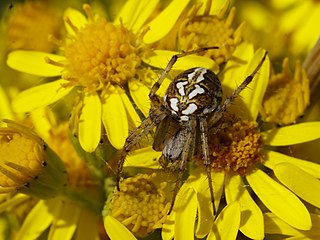
Neoscona, known as spotted orb-weavers and barn spiders, is a genus of orb-weaver spiders (Araneidae) first described by Eugène Simon in 1895 to separate these from other araneids in the now obsolete genus Epeira. The name Neoscona was derived from the Greek νέω, meaning "spin", and σχοῖνος, meaning "reed" They have a mostly pantropical distribution and one species, Neoscona adianta, has a palearctic distribution. As of April 2019 there are eight species that can be found in the United States and Canada:
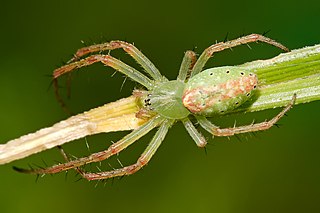
Cyrtophora, the tent-web spiders, is a genus of orb-weaver spiders first described by Eugène Simon in 1895. Although they are in the "orb weaver" family, they do not build orb webs. Their tent-like, highly complex non-sticky web is sometimes considered a precursor of the simplified orb web. These webs are aligned horizontally, with a network of supporting threads above them. These spiders often live in colonies. Females have a body length of mostly about 10 millimetres (0.39 in) long. Some members, including Cyrtophora cicatrosa, exhibit the ability to change colour rapidly.
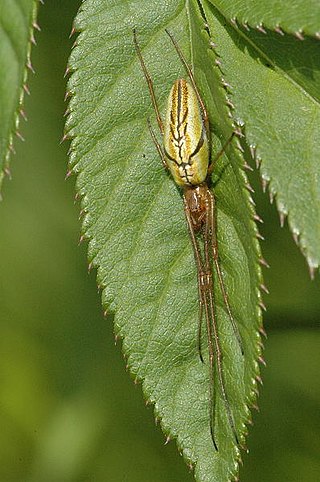
Tetragnatha is a genus of long-jawed orb-weavers found all over the world. It was first described by Pierre André Latreille in 1804, and it contains hundreds of species. Most occur in the tropics and subtropics, and many can run over water. They are commonly called stretch spiders in reference to their elongated body form and their ability to hide on blades of grass or similar elongated substrates by stretching their front legs forward and the others behind them. The name Tetragnatha is derived from Greek, tetra- a numerical prefix referring to four and gnatha meaning "jaw". Evolution to cursorial behavior occurred long ago in a few different species, the most studied being those found on the Hawaiian islands. One of the biggest and most common species is T. extensa, which has a holarctic distribution. It can be found near lakes, river banks or swamps. Large numbers of individuals can often be found in reeds, tall grass, and around minor trees and shrubs.

Phonognatha is a genus of South Pacific orb-weaver spiders first described by Eugène Simon in 1895. It was originally placed with the long-jawed orb weavers, and was moved to Araneidae in 2008.

Arkys, also known as triangular spider or ambush spider, is a genus of Australian araneomorph spiders in the family Arkyidae, first described by Charles Athanase Walckenaer in 1837. They are often small, with a triangular shaped abdomen, and are found in Australia and some of its surrounding islands. They don't build webs, but can often be found on leaves and tips of flower heads. Their egg sacs are pinkish-orange and spherical, and are made late in the summer.

Socca pustulosa, commonly called the knobbled orbweaver or garden orb weaver spider, is a common small species of spider found in Australia and New Zealand.

Larinia is a genus of orb-weaver spiders first described by Eugène Simon in 1874.

The spider species Plebs eburnus is commonly referred to as the eastern grass orb-weaver or the eastern bush orb-weaver, and sometimes more simply as the bush orb-weaver. It is an orb-weaver spider from the family Araneidae endemic to Australia. It is a very common spider with distinctive white markings, which give it the species name eburnus pertaining to ivory. It is found in scrub and tall grasses where the female constructs a vertical web usually no more than 2 metres from the ground, and stays there day and night. The web of some of these spiders has been seen to be decorated with nearly vertical stabilimentum. The stabilimentum of the related P.cyphoxis is usually observed vertical.

Plebs is a genus of orb-weaver spiders first described by M. M. Joseph & V. W. Framenau in 2012. Though many of its species have been moved around, a 2012 taxonomic revision suggested that these spiders comprise a monophyletic genus of closely related spiders that evolved in Australia and, through subsequent movements, spread into parts of Asia and Pacific islands.
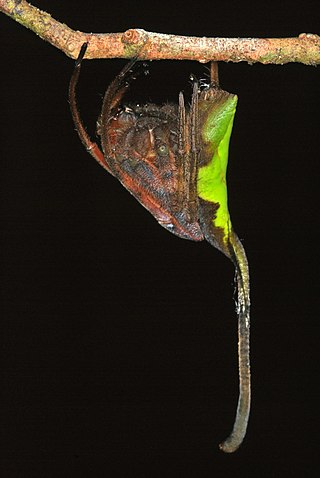
Poltys is a genus of orb-weaver spiders first described by C. L. Koch in 1843. Many species are cryptic and are known to masquerade as leaves and twigs during the day, and build an orb web at night to capture prey. The shape of the abdomen which often gives the impression of a rough and broken branch can vary among individuals within a species. The web is eaten up before dawn and reconstructed after dusk.

Arkyidae, also known as triangular spiders, is a family of araneomorph spiders first described by Ludwig Carl Christian Koch in 1872 as a subfamily of Araneidae, and later elevated to a full family in 2017.

Backobourkia is a genus of South Pacific orb-weaver spiders first described by Volker Framenau, Nadine Dupérré, Todd Blackledge & Cor Vink in 2010. It is a common Australian spider, closely related to Eriophora and placed in the "coxal hook clade" of the Araneinae subfamily of Araneidae. Females are generally the same size among all species, but males are much smaller, suggesting male dwarfism throughout the genus. The genus name is a play on the well-known Australian idiom, "Back of Bourke", meaning very remote and beyond the limits of civilization.
Carepalxis is a genus of orb-weaver spiders first described by Ludwig Carl Christian Koch in 1872. These spiders only build webs at night and break them down in the morning. C. coronata builds orb webs up to 60 centimetres (24 in) in diameter with closely woven spiral threads.

Dolophones is a genus of orb-weaver spiders first described by Charles Athanase Walckenaer in 1837.
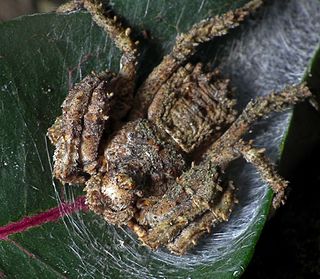
Stephanopis is a genus of crab spiders first described by Octavius Pickard-Cambridge in 1869. It was erected for five then newly described species, including S. altifrons, from Australia. Stephanopis was characterized by the high cephalic region with unequally sized anterior eyes disposed in a strongly recurved row, opisthosoma ending in several spiniform projections and dorsoventrally depressed habitus. According to Pickard-Cambridge, the single specimen used for the description of S. altifrons was dry-pinned. Therefore the specimen could not be properly examined, so it was not possible to determine if the specimen was adult. Moreover, he states his own sketch of the spider as “hasty”. This may explain why the somatic characters were inadequately described, genitalic features were not mentioned at all, and the illustrations were not detailed enough, making the species unidentifiable.
















